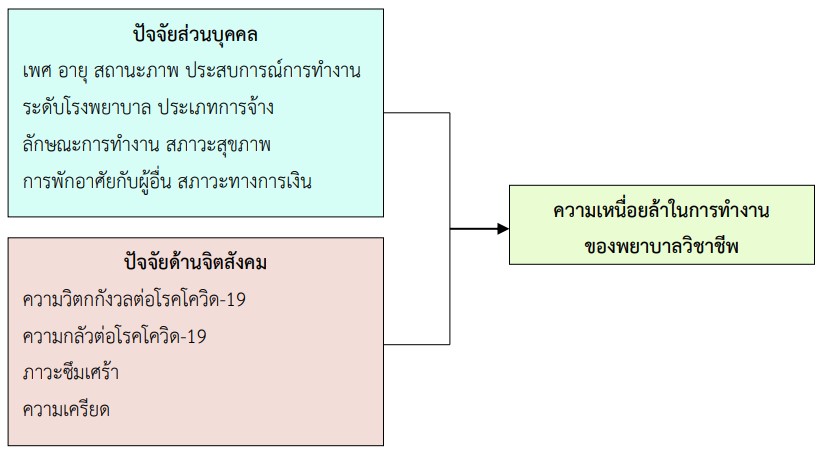Factors Affecting of Professional Burnout among Registered Nurses in Health Region 8 During the COVID-19 Pandemic
Keywords:
Coronavirus 19, Professional Nurses, Fear, Depression, BurnoutAbstract
This cross-sectional study aimed to examine professional burnout and the factors that affected burnout among professional nurses in Health Region 8 during the COVID-19 pandemic. Participants were 247 nurses who worked in public hospitals under the Ministry of Public Health in Health Region 8. The research tools used included questionnaires on demographic data questionnaire, COVID-19 Anxiety Scale (CAS), Fear of COVID-19 (FCV-19S), Stress Test-5 (ST-5), The Patient Health Questionnaire (PHQ-9) and Thai version Copenhagen burnout inventory (T-CBI scale). The Cronbach's alpha coefficients for these scales were 0.91, 0.90, 0.90, 0.92 and 0.98, respectively. Data were analyzed using descriptive statistics and multiple logistic regression.
The research results found that factors associated with burnout among professional nurses included job characteristics, fear, and depression (p-value < 0.05). Professional nurses working in sub-district health-promoting hospitals experienced burnout 5.41 times higher (AOR = 5.41, 95% CI: 1.44-20.28) compared to inpatient department nurses. Professional nurses with high levels of fear of COVID-19 experienced burnout 2.25 times higher (AOR = 2.25, 95% CI: 1.20-4.21) compared to those with low levels of fear. Meanwhile, professional nurses with high levels of depression experienced burnout 4 times higher (AOR = 4.00, 95% CI: 1.85-8.67) compared to those with low levels of depression. Therefore, it is recommended to provide additional staffing and morale-boosting activities to support nurses, particularly those on the front lines, to reduce fear and depression, which are causes of burnout.
References
นิตยา เพ็ญศิรินภา. (2566). ภาวะเหนื่อยล้าจากงานของบุคลากรด้านสุขภาพโรงพยาบาลส่งเสริมสุขภาพตำบลจังหวัดนนทบุรีในช่วงโรคโควิด-19 ระบาด. วารสารวิชาการสาธารณสุขชุมชน, 9(1), 84-84.
อัจฉรา คำมะทิตย์ และกิตติพร เนาว์สุวรรณ. (2565). อิทธิพลด้านจิตสังคมที่ส่งผลต่อความเหนื่อยล้าในการเรียนของนักศึกษาพยาบาล สถาบันพระบรมราชชนก ในสถานการณ์การแพร่ระบาดของโรคติดเชื้อไวรัสโคโรนา 19. วารสารมหาวิทยาลัยนราธิวาสราชนครินทร์, 14(2), 56-76.
Abdelghani, M., El-Gohary, H. M., Fouad, E., & Hassan, M. S. (2020). Addressing the relationship between perceived fear of COVID-19 virus infection and emergence of burnout symptoms in a sample of Egyptian physicians during COVID-19 pandemic: A cross-sectional study. Middle East Current Psychiatry, 27(1), 70. https://doi.org/10.1186/s43045-020-00079-0
Ahorsu, D. K., Lin, C. Y., Imani, V., Saffari, M., Griffiths, M. D., & Pakpour, A. H. (2022). The Fear of COVID-19 Scale: Development and initial validation. International Journal of Mental Health and Addiction, 20(3), 1537-1545. https://doi.org/10.1007/s11469-020-00270-8
Ahorsu, D. K., Lin, C. Y., Marznaki, Z. H., & H Pakpour, A. (2022). The association between fear of COVID-19 and mental health: The mediating roles of burnout and job stress among emergency nursing staff. Nursing Open, 9(2), 1147-1154. https://doi.org/10.1002/nop2.1154
Allen, M. & Cug, J. (2020). Demoralization, fear, and burnout associated with being a COVID-19 frontline healthcare worker. Psychosociological Issues in Human Resource Managment, 8(1), 43-48. https://doi.org/10.22381/pihrm8120207
Bellanti, F., et al. (2021). Factors related to nurses’ burnout during the first wave of coronavirus disease-19 in a university hospital in Italy. International Journal of Environmental Research and Public Health, 18(10), 5051. https://doi.org/10.3390/ijerph18105051
Çağış, Z. G. & Yıldırım, M. (2023). Understanding the effect of fear of COVID-19 on COVID-19 burnout and job satisfaction: A mediation model of psychological capital. Psychology, Health & Medicine, 28(1), 279-289. https://doi.org/10.1080/13548506.2022.2077970
Ching, S. M., et al. (2021). Psychological distress among healthcare providers during COVID-19 in Asia: Systematic review and meta-analysis. PLOS ONE, 16(10), e0257983. https://doi.org/10.1371/journal.pone.0257983
Hu, D., et al. (2020). Frontline nurses’ burnout, anxiety, depression, and fear statuses and their associated factors during the COVID-19 outbreak in Wuhan, China: A large-scale cross- sectional study. EClinicalMedicine, 24, 100424. https://doi.org/10.1016/j.eclinm.2020.100424
Jihn, C. H., Kim, B., & Kim, K. S. (2021). Predictors of burnout in hospital health workers during the COVID-19 outbreak in South Korea. International Journal of Environmental Research and Public Health, 18(21), 11720. https://doi.org/10.3390/ijerph182111720
Lee, S. A. (2020). Coronavirus Anxiety Scale: A brief mental health screener for COVID-19 related anxiety. Death Studies, 44(7), 393-401. https://doi.org/10.1080/07481187.2020.1748481
Leo, C. G., et al. (2021). Burnout among healthcare workers in the COVID 19 era: A review of the existing literature. Frontiers in Public Health, 9, 750529. https://doi.org/10.3389/fpubh.2021.750529
Lotrakul, M., Sumrithe, S., & Saipanish, R. (2008). Reliability and validity of the Thai version of the PHQ-9. BMC Psychiatry, 8, 46. https://doi.org/10.1186/1471-244x-8-46
Phuekphan, P., Aungsuroch, Y., Yunibhand, J., & Chan, S. W. C. (2016). Psychometric properties of the Thai version of Copenhagen Burnout Inventory (T-CBI) in Thai nurses. Journal of Health Research, 30(2), 135-142. https://doi.org/10.14456/JHR.2016.19
Rahman, M. A., et al. (2021). COVID-19: Factors associated with psychological distress, fear and coping strategies among community members across 17 countries. Globalization and Health, 17(1), 117. https://doi.org/10.1186/s12992-021-00768-3
Raja, U., Jahanzeb, S., Malik, M. A. R., & Baig, M. U. A. (2022). Dispositional causes of burnout, satisfaction and performance through the fear of COVID-19 during times of pandemic. Applied Psychology. https://doi.org/10.1111/apps.12417
Sagaltici, E., Saydam, R. B., Cetinkaya, M., Şahin, Ş. K., Küçük, S. H., & Müslümanoğlu, A. Y. (2022). Burnout and psychological symptoms in healthcare workers during the COVID-19 pandemic: Comparisons of different medical professions in a regional hospital in Turkey. Work (Reading, Mass.), 72(3), 1077-1085. https://doi.org/10.3233/WOR-210517
Thorndike, R. M. (1978). Correlational procedures for research. New York: Garner Press.

Downloads
Published
How to Cite
Issue
Section
License
Copyright (c) 2024 Journal of Nursing and Public Health Research

This work is licensed under a Creative Commons Attribution-NonCommercial-NoDerivatives 4.0 International License.
1. บทความหรือข้อคิดเห็นใด ๆ ที่ปรากฏในวารสารวิจัยการพยาบาลและการสาธารณสุข ที่เป็นวรรณกรรมของผู้เขียน บรรณาธิการไม่จำเป็นต้องเห็นด้วย
2. บทความที่ได้รับการตีพิมพ์ถือเป็นลิขสิทธิ์ของ วารสารวิจัยการพยาบาลและการสาธารณสุข








